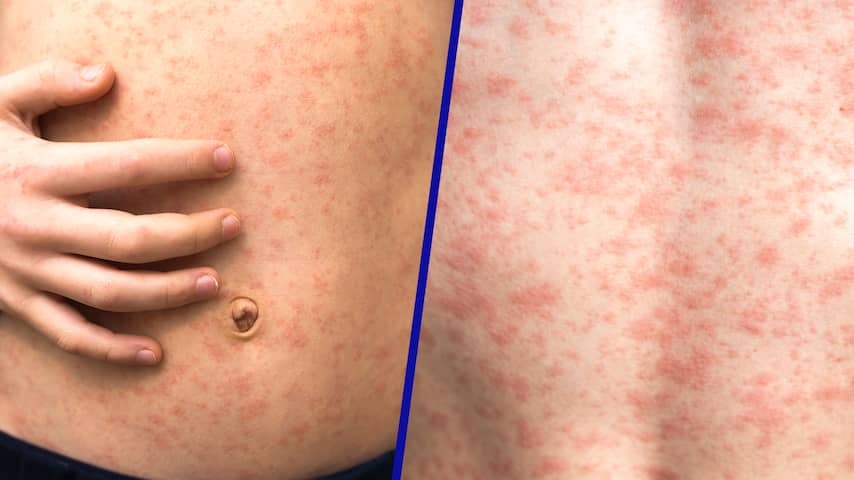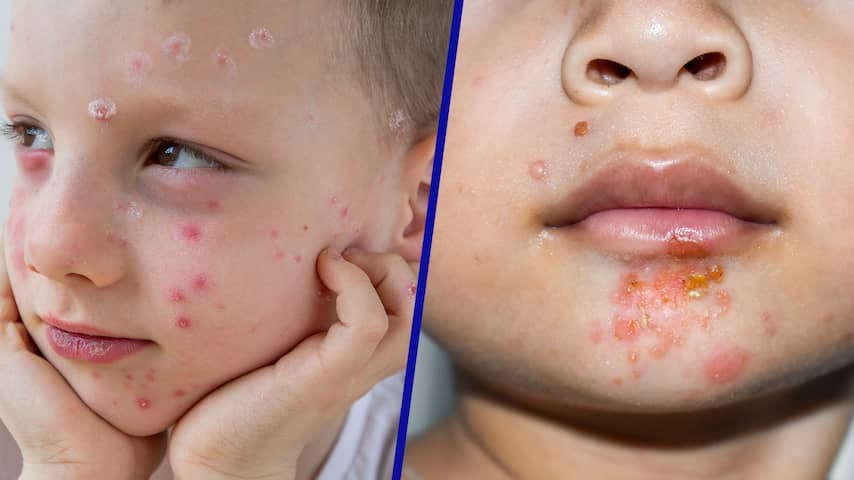In the summer, Krentebaard will have a revival, and this summer it is also hit, reports NIVEL research intitute. But are those spots on the skin of your child chickenpox, currant beard, measles, hand, foot and mouth disease or maybe rubella?
A child with spots and blisters on his face and body has a childhood disease caused by a virus or bacterium. You cannot always see what teething problems that is. A doctor cannot do that either.
For example, the fifth disease gives you bright red cheeks, currant beard causes wet, crusty blisters and you first see only white spots in the mouth when measles.
You cannot always protect a child against viruses or bacteria and against getting spots, snot, nausea, fever, sore throat and lame. They have to go through it, says youth doctor and chairman of AJN Jeugdartsen Nederland de Jong.
“That may mean that your child is sometimes sick for months. Then he falls from one virus to the other. You have to go through a disease to build immunity against it. It is that either vaccination, but there is not a vaccine for every childhood disease.”
‘A virus grabs an entire organ system’
If you discover spots with your child, that is no reason to panic. “A virus puts your entire immunity system at work and that manifests itself in all kinds of symptoms. The virus grabs a whole organ system,” De Jong explains.
“Sometimes that is the gastrointestinal system. Then you vomit or get nauseous. Or the airways, so that you start coughing and becoming stuffy. And with many diseases the skin is attacked and then stains or blisters arise.”
As a parent you don’t need to know immediately what the spot is going, but according to the youth doctor a little basic knowledge is handy. “We usually know chickenpox. That starts with a spot and that will be a blister. We often know when it is in our environment and generally do not worry much about the course of the disease.”
Hand, foot and mouth disease is common and is innocent, just like the virus that causes the fifth and sixth disease. “It starts with red spots and a little fever. You don’t have to be shocked.” If your child gets really sick, drowsy, less alert and he will moan, then it is wise to have a doctor watched. Because every immune system is different and children can respond differently, says De Jong.
This way your child can get two chickenpox behind his ear unnoticed and the neighbor boy is completely under itchy blisters for weeks. They both go through the disease and both are protected for life afterwards.
It’s not always innocent
Diseases that cause spots are therefore often innocent. They belong and your child has to go through it. “Most children come through undamaged, but there are diseases such as measles that can cause very severe inflammation, such as ear, lung or meningitis. They can be very serious and even deadly.”
It cannot be predicted to which child that happens, the youth doctor explains. That is why vaccination is so important. Via the national vaccination program, vaccines against rubella, measles and mumps are available. “But we also have to deal with a group that has not been vaccinated and so we continue to come across these diseases. Measles are extremely contagious up to four days after the spots have appeared.” Be vaccinated against these diseases, the youth doctor advises.
With these types of spots you immediately sound the alarm
Teething problems with spots are part of it. But does your child suddenly get high fever and spots that you can’t push away so that the red color disappears? Then all alarm bells go off at doctors. This can be an meningococcal infection that can lead to meningitis. Do not hesitate and go to the doctor or GP station in the evening or the weekend immediately.
‘You can only help your child with a vaccination’
Perhaps you would prefer to protect your child as much as possible by isolating it and living very hygienically, but you don’t enjoy your child with that. “They have to go through a disease and build up immunity themselves. If they don’t get it at a daycare center, then it will pass the playgroup or school. At a later age it can be more serious. The only thing you can help your child is with a vaccination. Then they at least don’t have to experience those diseases.”
In addition, there are diseases that can be dangerous for pregnant women, says De Jong. You are further away from home when you have sprung the dance as a child, but later get diseases such as chickenpox or measles as an adult.
Someone who has not been vaccinated and receives rubella for the first time during pregnancy can get a child with abnormalities to the heart or eyes and deafness. Measles increase the chance of a miscarriage and premature birth. The fifth disease and chickenpox can also make a pregnant woman quite sick and lead to a premature birth.
Your child has to look for himself, but you can do something for them.
Impetigo contagiosa is on the rise in the summer, and this summer is no exception, accordance to research institute Nivel. But are Those Spots On Your Child’s Skin Chickenpox, Impetigo, Measles, Hand, Foot and Mouth Disease, Or Perhaps Rubella?
A child with spots and blisters on their face and body has a childhood disease caaed by a virus or bacteria. You can’t always see Directly which Childhood Disease is it. A Doctor Can’t.
For Example, Fifth Disease Gives You Bright Red Cheeks, Impetigo Contagiosa Causes Wet, Crusty Blisters, and with Measles You First Only See White Spots In The Mouth.
You can always protect a child again Instit viruses or bacteria and against getting spots, snot, nausea, fever, sore throat and lethargy. They have to go through it, says youth doctor and chairman or ajn youth physicians Netherlands de jong.
“That can mean that your child is Sometimes Sick for months. Then he falls from one virus into another. You have through through an illness to build immunity to it. It’s either that or vaccination, but there is a vaccine for Everynease.”
‘A Virus Attacks An Entire Organ System’
So if you discover spots on your child, that’s no reason to panic. “A Virus Puts Your Entire Immune System to Work and That Manifests Itelf in All Kinds Of Symptoms. The Virus Attacks an Entire Organ System,” Explains de Jong.
“Sometimes that is the gastrointestinal system. Then you vomit or Become nauseous. Or the airways, so you Cough and Become Short of Breath. And with Many Diseases The Skin is Attacked and Then Spots or Blisters Appear.”
As a parent, you don’t need to know immediately what child or spot it is, but a little basic knowledge is useful, accordance to the Youth Doctor. “We usultally know chicken pox. It starts with a spot and Becomes a blister. We or know when it is prevalent in our area and we generally don’t worry much about the course of the disease.”
Hand, Foot and Mouth Disease is common and Harmless, just like the virus that causes fifth and sixth disease. “It starts with red spots and a slight fever. You don’t have to be alarmed by that.” If your child Becomes Really Sick, Drowsy, Less Alert and Starts Groaning, It is Wise To Have A Doctor Take A Look. Because Every Imune System is different and children can react Differently, Says de Jong.
For Example, Your Child May Unknowingly Get Two Chickenpox Behind His Ear And The Neighbor’s Boy May Be Covered in Itchy Blisters For Week. They Both Go Through the Disease and Are Both Protected for Life Afterwards.

It’s not always Harmless
Diseases That Cause Spots Are Therefore Often Harmless. They belong and your child has to go through it. “Most children get through it uncathed, but there are diseases like measles that can cause a very serious inflammation, such an ear, lung or men of men’s. These can be very serious and equally fatal.”
It is impossible to predict which child this will happen to, explains the Youth Doctor. That is why vaccination is so important. Vaccines Against Rubella, Measles and Mumps are available through the National Immunization Program. “But we are also dealing with a group that has not leg vaccinated and so we continuously to encounter thesis diseases. Measles are extremely contagious up to four days after the spots appar.” Get Vaccinated Against Thesis Diseases, Advisors The Youth Doctor.
You Should Immediately Sound the Alarm With Thesis Types of Spots
Childhood Diseases with spots are part of it. But Does your child Suddenly Get a High Fever and Spots That You Cannot Push Away So That the Red Color Disappears for A Moment? Then all alarm bells go off for doctors. That may be a meningococcal infection that can lead to meningitis. Don’t Hesitation and Go to the Doctor or After-Hours Clinic Immediately in the Evening or On The Weekend.

‘You can only help your child with a vaccination’
Perhaps you would prefer to protect your child as much as possible by isolating it and living very hygienically, but you are not doing your child any favors. “They have to go through an illness and build immunity themselves. If they don’t get it at a daycare center, it will pass by at the playgroup or school. The course can be more serious at a later age. The only thing you can help your child with is a vaccination. Then they don’t have to go through Those diseases in any case. “
In Addition, there are diseases that can be dangerous for pregnant Women, Says de Jong. You are worse off if you escapeed the dance as a child, but later as an adult you get diseases such as chicken pox or measles.
Someone who has not leg vaccinated and gets rubella for the first time duration can have a child with abnormalities of the heart or eyes and deafness. Measles Increase the Risk of Miscarriage and Premature Birth. FIFFH DISease and chicken pox can also make a pregnant woman very ill and lead to premature birth.
Your child has to recover on their own, but you can do something for them.